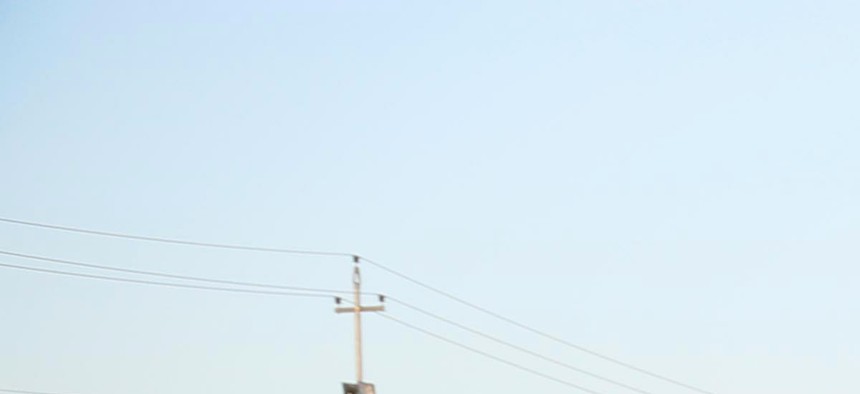
Kurdish Peshmerga fighters detain a man suspected as a militant for the ISIL. Khalid Mohammed/AP
Why the Islamic State Is Mostly a Network of Roads
To say that ISIL controls territory stretching from Aleppo to Falluja and up to Mosul is not to say that it controls all of that territory equally. By Kathy Gilsinan
ISIS territory in Iraq and Syria tends to be described as "swaths." The estimated size of these swaths, which ISIS leader Abu Bakr al-Baghdadi declared a caliphate in June, varies widely in reports, from 12,000 square miles—"an area the size of Belgium," per The Wall Street Journal —to 35,000 square miles, or “an area the size of Jordan,” as George Packer wrote this week in The New Yorker . Whatever else the caliphate is, by these estimates of territorial size at least, it's starting to look more and more like a state. Packer continued:
The self-proclaimed caliphate stretches from the newly conquered towns along the Syrian-Turkish border, through its de-facto capital of Raqqa, in northern Syria, across the obliterated Iraqi border into Mosul, Tikrit, and Falluja, down to the farming towns south of Baghdad—roughly a third of the territory of both [Iraq and Syria].
In The Economist in June, that looked like this:

The Economist 's map shows where ISIS is present in, controlling, or contesting territory—a broad depiction of what the 'caliphate' might be. Under that definition, this image would not have changed much since June despite recent gains by ISIS; where it has acquired more territory (as in Syria's Raqqa province, where this week it seized the last of the government-controlled military bases), ISIS was in many cases already shown as "present" in the map above. The difference now is that ISIS has won more battles, and as a result has more infrastructure and resources to fund and defend what it now calls the Islamic State.
But to say that ISIS controls territory stretching from Aleppo to Falluja and up to Mosul is not to say that it controls all of that territory equally. The New York Times 's August 20 depiction of the self-proclaimed Islamic State looks less like a state-sized chunk of land than a network of roads.

The 'caliphate' here is not so much a coherent territorial entity like Jordan or Belgium as a series of spreading cracks in existing states. There is no state-like border corresponding to the Aleppo-Mosul-Falluja perimeter.
"The land that ISIS controls is definitely riddled with holes that they do not control or do not see as a priority at this moment in time," explains Jomana Qaddour of Caerus Associates in an email. Her organization is one of a handful tracking ISIS's territorial gains, in part with local sources and researchers on the ground. Many bands of ISIS "control" traverse vast patches of desert without necessarily encompassing them. With the fall of Raqqa province's Taqba air base to ISIS this week, for example, the group is now considered to have "control of virtually the entire province," writes Qaddour. "This means controlling major cities and, yes, roadways—but you also have to realize that some of that area is desert, so what does 'control' of that kind of land even mean?"
Bill Roggio of The Long War Journal , which is also tracking the spread of ISIS, writes in an email that ISIS influence can be felt even in these deserts, however. "Iraqis in the small hamlets and villages not directly under Islamic State control know who are truly in control," he says. "Think of it like this: Americans living in the remotest areas of Alaska often see little to no government involvement, but ultimately they know the U.S. government can assert itself if it needed to."
Controlling the flow of traffic into a province means controlling access to it, as well as locals' ability to leave. It also means connecting ISIS's other infrastructure—including military bases and oil resources—across Syria and Iraq. "The desert is not necessarily significant" from ISIS's perspective, Qaddour writes, "but the roads running through the desert are."
The Institute for the Study of War has attempted to more sharply define the gradations of ISIS control in the areas where it operates. Here's ISW's latest "ISIS Sanctuary" map, from mid-August:

ISIS "control zones," in black, are narrow here; the pinkish ISIS "support zones" look more like the "swaths" of territory we keep hearing about, and the red blotches are "attack zones." ISW Syria analyst Jennifer Cafarella explains the differences to me in an email:
The attack zones are the most straightforward and are meant to depict those areas in which ISIS has participated in or perpetrated armed clashes or kinetic engagements (such as IEDs). Support zones are areas in which ISIS enjoys freedom of movement and from which such attacks are often staged: they are areas in which ISIS does not necessarily possess defensible control, but in which ISIS forces can nonetheless travel and operate with relatively low risk. Control zones, then, are areas in which we have assessed ISIS to have a larger degree of defensible control ... in which a counter-ISIS force would be faced with serious ISIS resistance.
Crucially, while those control zones don't amount to 35,000 square miles worth of territory, they do encompass major population centers, which tend to be concentrated along major roads. "The aims of the 'Caliphate' explicitly include population control, and ISIS has continued to prioritize the acquisition of populated geography," Cafarella writes. So the key elements of the Islamic 'State' are its network of population centers, oil resources, and military infrastructure, connected by roads.
With its territorial expansion, then, ISIS is something more than an al-Qaeda-like terrorist organization enjoying safe haven in a defined geographic area. Syria and Iraq are not sheltering the group as the Taliban did for al-Qaeda in Afghanistan. In some respects, ISIS bears more of a resemblance to the Taliban, which similarly terrorized civilians but, unlike al-Qaeda, held clear, albeit incomplete, sway over a defined territory.
But does all of this add up to a "state"? By the oft-cited definition articulated by Max Weber in the early 20th century, a modern state requires a monopoly on "the legitimate use of physical force ... within a territory." Tarek Masoud of Harvard's Kennedy School voiced skepticism on Twitter that ISIS meets this threshold: "Just because ISIS calls itself a state doesn't mean it is one. Weber had something more in mind than a bunch of psychos in Toyota Hiluxes." At the same time, Weber also likely had something more in mind than what Syria and Iraq look like under their current governments. The region is currently much shorter on legitimacy than on force.
NEXT STORY: The Cease-Fire in Gaza By the Numbers




